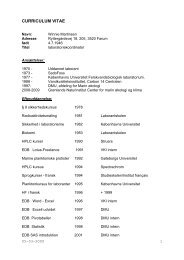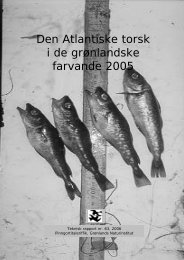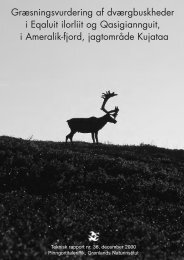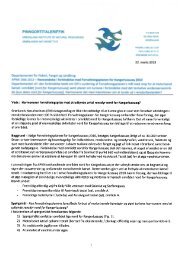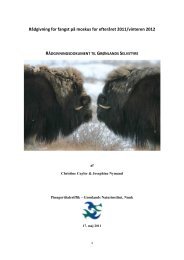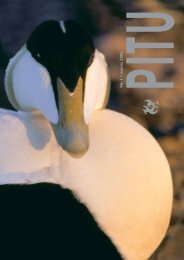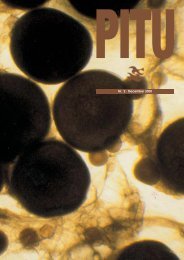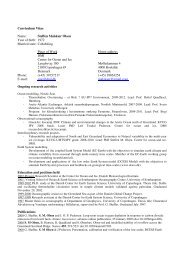Migration and breeding biology of Arctic terns in Greenland
Migration and breeding biology of Arctic terns in Greenland
Migration and breeding biology of Arctic terns in Greenland
You also want an ePaper? Increase the reach of your titles
YUMPU automatically turns print PDFs into web optimized ePapers that Google loves.
18<br />
2004). Although poorly understood <strong>and</strong> documented <strong>in</strong> the literature, it<br />
is important to address whether variations <strong>in</strong> colony size may be caused<br />
by locally occurr<strong>in</strong>g phenomena, such as predation <strong>and</strong> disturbance, or if<br />
these variations are l<strong>in</strong>ked to large scale events, such as food availability<br />
or climatic variations. In order to make sense <strong>of</strong> counts at <strong>Arctic</strong> tern colonies<br />
where variation occurs, it is important to underst<strong>and</strong> the scale (from<br />
with<strong>in</strong>-colony to regional scale) at which variations <strong>in</strong> colony attendance<br />
occur. A particular comb<strong>in</strong>ation <strong>of</strong> factors makes it diffi cult to address<br />
population size, status, <strong>and</strong> trends <strong>in</strong> <strong>Arctic</strong> <strong>terns</strong> (Ratcliffe 2004). This is<br />
most pronounced <strong>in</strong> the <strong>Arctic</strong> zone where <strong>Arctic</strong> tern <strong>breed<strong>in</strong>g</strong> sites may<br />
be diffi cult to access <strong>and</strong> colonies can be widely distributed.<br />
In addition to estimates <strong>of</strong> population size from the two study sites, Kitsissunnguit<br />
(2002-2006) <strong>and</strong> S<strong>and</strong> Isl<strong>and</strong> (2006-2009), it was possible to conduct<br />
annual counts <strong>in</strong> 14 <strong>Arctic</strong> tern colonies <strong>in</strong> the southern part <strong>of</strong> Disko<br />
Bay (the Akunnaaq area) <strong>in</strong> the period 2002-2005 (Manus IV). Considerable<br />
fl uctuation was found between years <strong>in</strong> these small <strong>and</strong> mid-sized<br />
colonies (mean CV <strong>of</strong> <strong>in</strong>dividual colonies equalled 117.5 %), whereas the<br />
colonies at Kitsissunnguit only showed m<strong>in</strong>or annual variation (47.4 % at<br />
sub-colony level, 14.6 % at overall level). When comb<strong>in</strong>ed, however, the<br />
total population size <strong>of</strong> the Disko Bay colonies (more that 80 % <strong>of</strong> the Artic<br />
tern colonies <strong>in</strong> Disko Bay), varied little (CV 6.7 %), <strong>in</strong>dicat<strong>in</strong>g local<br />
movements between the colonies <strong>and</strong> that annual variation was l<strong>in</strong>ked to<br />
locally occurr<strong>in</strong>g phenomena.<br />
Variation at high-arctic S<strong>and</strong> Isl<strong>and</strong> was even more pronounced, with complete<br />
<strong>breed<strong>in</strong>g</strong> failures recorded <strong>in</strong> two out <strong>of</strong> four seasons (Manus IV).<br />
1.7 Plausible cause <strong>of</strong> decl<strong>in</strong>e <strong>in</strong> population size<br />
<strong>Arctic</strong> tern populations <strong>in</strong> Greenl<strong>and</strong> are affected by numerous factors regulat<strong>in</strong>g<br />
population size <strong>and</strong> the observed long-term decl<strong>in</strong>e is likely to be<br />
caused by more than one factor. <strong>Arctic</strong> foxes (Alopex lagopus) are known to<br />
cause devastat<strong>in</strong>g predation when they are able to access a colony (Bianki<br />
<strong>and</strong> Isaksen 2000, Manus IV), <strong>and</strong> multiple avian predators are known to<br />
depredate egg, chicks, <strong>and</strong>, to a lesser degree, adult <strong>Arctic</strong> <strong>terns</strong> (Cramp<br />
1985, Hatch 2002). Although these predators have always been present <strong>in</strong><br />
Greenl<strong>and</strong>, local Inuit claim that the number <strong>of</strong> predators <strong>in</strong> Greenl<strong>and</strong><br />
has <strong>in</strong>creased, caus<strong>in</strong>g <strong>terns</strong> to decl<strong>in</strong>e. Although the relationship between<br />
food availability <strong>and</strong> reproductive performance <strong>in</strong> <strong>Arctic</strong> <strong>terns</strong> <strong>in</strong> Greenl<strong>and</strong><br />
is poorly documented, the study on chick diet <strong>and</strong> chick survival at<br />
Kitsissunnguit (Table 2, Manus III) <strong>in</strong>dicates that productivity is low compared<br />
with other studies abroad (Appendix I <strong>in</strong> Hatch 2002). Food shortage<br />
or <strong>in</strong>accessibility <strong>of</strong> suitable prey items can occur <strong>in</strong> Greenl<strong>and</strong> waters<br />
<strong>and</strong> may affect the ability <strong>of</strong> <strong>Arctic</strong> <strong>terns</strong> to reproduce <strong>in</strong> some years.<br />
In Greenl<strong>and</strong>, harvest<strong>in</strong>g <strong>of</strong> <strong>Arctic</strong> tern eggs for consumption has probably<br />
taken place as long as humans have <strong>in</strong>habited the country (Manus II).<br />
The impact <strong>of</strong> this harvest<strong>in</strong>g was <strong>in</strong>itially constra<strong>in</strong>ed by a small human<br />
population size <strong>and</strong> limited forms <strong>of</strong> transportation. The human population<br />
<strong>in</strong> Greenl<strong>and</strong> has more than quadrupled s<strong>in</strong>ce the 1950’s (Fægteborg<br />
2000), however, <strong>and</strong> the number <strong>and</strong> size <strong>of</strong> motorized boats has <strong>in</strong>creased<br />
rapidly, allow<strong>in</strong>g greater mobility, <strong>and</strong> likely <strong>in</strong>creas<strong>in</strong>g pressure on the<br />
<strong>Arctic</strong> tern population.





